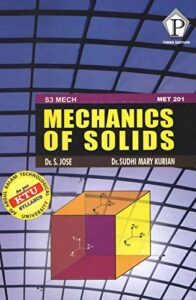
Course code : PCMET302
Course name : Mechanics of Solids
Course Pre / Co-requisite : None
Course Objectives
- To acquaint with the basic concepts of stress and deformation in solids.
- To practice the methodologies to analyse stresses and strains in simple structural members, and to apply the results in simple design problems.
Course Outcomes
On successful completion of this course students shall be able to
CO1: Determine the stresses and strains in deformable bodies subjected to different types of external loads and thermal effects
CO2: Analyse the torsion of circular bars and draw the shear force and bending moment diagrams for beams
CO3: Determine the stresses and deflections in beams subjected to transverse loads
CO4: Determine analytically and graphically the principal stresses and planes for structural members subjected to loads and analyse the strength of columns
Text Books (T)
T1. Mechanics of Solids, R. K. Bansal, Laxmi Publications, 2012
T2. Mechanics of Solids, S. S. Bhavikatti, New Age International, 2013
T3. Strength of Materials, Surendra Singh S. K, Kataria & Sons, 2013
T4. Strength of Materials, Rattan, McGraw Hills, 2011
Reference Books (R)
R1. Mechanics of materials, R. C. Hibbeler, Pearson Higher Education, 2018
R2. Engineering Mechanics of Solids, Popov E, PHI, 2002
R3. Mechanics of Materials, Beer & Johnston, McGraw Hills, 2017
R4 Mechanics of Materials, Pytel A. and Kiusalaas J, Cengage Learning India Private Limited, 2015
Curriculum
- 4 Sections
- 8 Lessons
- 10 Weeks
- Module 1 - Stress and strain relationshipIntroduction to analysis of deformable bodies. Types of external loads - Normal, Shear, Bending and Bearing stress- Linear and Shear strains. Hooke’s law - Stress-Strain diagrams - concepts of Isotropy, Orthotropy, Anisotropy. Young’s Modulus, Bulk Modulus and Rigidity Modulus. Poisson’s ratio - Relationship between elastic constants. Deformation in axially loaded bars –uniform cross section, varying cross section, dissimilar materials, principle of superposition. Thermal effects – simple, composite bars.2
- Module 2 - Torsion and BendingTorsion: Shafts - torsion theory of elastic circular bars – assumptions and limitations – polar modulus - torsional rigidity – shaft design for torsional load. Beams- Classification - Diagrammatic conventions for supports and loading Differential equations between load, Shear Force and Bending Moment- Shear Force and Bending Moment Diagrams of Cantilever and Simply supported beam with Point load/UDL. Point of Inflection.2
- Module 3 - Deflection of BeamsStresses in Beams: Pure Bending – Flexure formula for beams - assumptions and limitations – Section Modulus - Flexural Rigidit - derivation and problems for rectangular section only -assumptions and limitations. Deflection of Beams: Moment-Curvature relation – assumptions and limitations - Double Integration method – Macaulay’s method.2
- Module 4 - Principal Stress and Buckling of columnsStress on an inclined plane due to Uniaxial stress- Stress on an inclined plane due to Biaxial stress- Stress on an inclined plane due to two Normal Stresses accompanied by Shear stresses- principal planes and stresses. Mohr’s circle of stress. Buckling and stability of long columns-Euler’s buckling/crippling load for columns with different end conditions- Euler equation derivation for both ends hinged only- Rankine’s formula2

